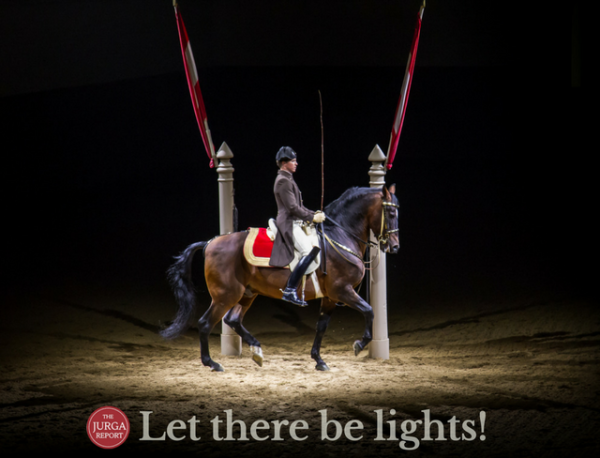Lights, cameras, Lipizzaners: The 450-year-old Spanish Riding School has seen the light
- March 10, 2017
- ⎯ Fran Jurga

If you ever want to spark conversation among equestrians, just ask casually, “What is the best kind of lighting for an indoor arena?”
Then just stand back, and wait for the differences of opinion and experience to begin.
Arena lighting is second perhaps only to footing as the great variable in arena engineering. It may also be one of the most expensive infrastructure projects for a horse farm. It’s hard to change lighting plans once they’re underway, and there’s a scarcity of independent, practical planning information for horse owners to be able to access.
All that changed today, when the first images taken under the new lighting system at the Spanish Riding School in Vienna, Austria. Part-theatrics, the new lights in the old Winter Riding Hall are designed to enhance the audience experience while watching the 450-year-old performance format.
Maybe the format hasn’t changed, and never will. Maybe the arena hasn’t changed, and never will. But a performance of the Spanish Riding School of Vienna will never look the same again.

On Saturday, November 26th, 300 guests uttered all the usual “oooh” and “ahhh” expressions so often heard when the 450-year-old Spanish Riding School performs its magnificent “white ballet”. But this time was different. The 300 lucky guests were seeing something never seen before.
“Firsts” don’t happen every day in an institution so old.
The same is true of the tack that each horse wears. The saddle design is classic. The harnessmaking skills are extraordinary. The riders carry the traditional birch strappings harvested from a local forest. But beginning last Saturday, the tack had a very modern alteration: each saddle is equipped with two electronic sensors. The pommel and cantle of each saddle are transmitting the location of each horse and rider throughout the routine, whether a solo leap in the capriole or the concerted efforts of the quadrille.
The saddles are not just carrying sensors, the sensors are transmitting wifi signals. Each horse is a target in a giant electronic grid encompassing every corner of the classic arena.
According to news shared today, the Spanish Riding School in Vienna had been looking for a lighting system to enhance the presentation of the performances. The new lighting solution created for the world’s oldest riding school tracks the small radio transmitters to follow each horse. Ten aerials that are mounted on the Riding Hall wall; they receive the transmitted radio signals and hence make it possible to accurately locate each horse.

The positions of the horses are then transmitted to the lighting system. After that, a specially developed software automatically controls the twenty LED-Movingheads (movable spotlights) installed on the upper gallery.
Thanks to the information relayed by the tracking system, the dynamic lights are angled in a way that ensures that the horses were always at the centre of the light, regardless of where they are in the arena.
The system was developed by the Viennese start-up company “zactrack” and its realization was supported by the Austrian lighting company Zumtobel Group.
An essential part of this process is that the software needs to calculate the direction in which the animal will be moving in advance so that the horse does not have to walk into the dark. “Horses are extremely sensitive and easily distressed by external influences. They do not notice the zactrack system, however, its mathematic calculation provides just enough light in front of them to ensure that they don’t have to walk into the dark,” said Werner Petricek, zactrack’s CEO.
In addition to the high-tech lighting sensors and illumination, the Lipizzaner stallions of the Spanish Riding School have their own low-tech lighting systems, also added in the past month. During November’s successful tour to the United Kingdom, the stallions began wearing specially designed crimson field and gold-edged saddlecloths, each embellished with 3,000 shining Swarovski crystals.
No doubt the lighting system will come in handy for more than the normal performances at the Riding School. The Lipizzaners occasionally do special performances, such as with the Viennese Boys Choir or an orchestra. The School is transformed each summer to the world’s most elegant ballroom for the fundraising Fête Imperiale, where classic Vienna waltzes send guests dancing around the space normally reserved for the world’s most famous dancing horses. Sometimes, the songs are even the same for the people and horses!
• • • • •
Riding arenas at farms and training centers may not be ready for the likes of Zamtrack technology yet, but the problem-solving used for the Spanish Riding School holds promise for what we may be able to do for and with out horses sometime in the future: forget the hazy yellow light, the burnt-out bulbs, the shadowy corners and the plea of “let’s go outside” when it’s time to take a photo. Lighting is part of the structural design for an arena but it is also plays a large part in the quality of the experience of riding. Just ask the world’s oldest riding school–they’ve seen the light, and look beautiful in it.








